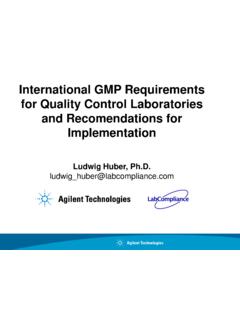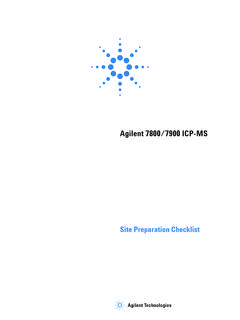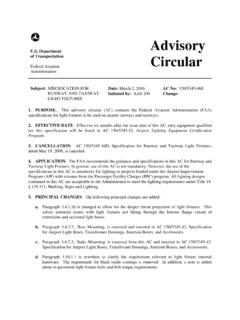Transcription of Sterilization - validation, qualification requirements
1 1 ISPE Boston ChapterFramingham MA 19 Sep20131 Sterilization - validation, qualification requirementsDawn Tavalsky2 Sterilization - OverviewObjectives Discuss definition of Sterile Briefly describe Sterilization methods Describe approaches to be used for the validation of a Sterilization process using Moist Heat as an example Describe requirements for routine monitoring and control of Sterilization Review issues that are specific to other Sterilization processes23 Sterile Products - Overview Certain pharmaceutical products must be sterile injections, ophthalmic preparations, irrigations solutions, haemodialysis solutions Two categories of sterile products those that can be sterilised in final container (terminally sterilised) those that cannot be terminally sterilised and must be aseptically prepared 4 Sterilization - OverviewWhat is the definition of sterile ? Free from microorganismsIn practice no such absolute statement regarding absence of microorganisms can be proven Defined as the probability of 1 in a million of a container being contaminated (10-6) This referred to as the Sterility Assurance Level (SAL) Organisms are killed in an exponential fashion35 Definition of Sterile MICROBIAL INACTIVATIONNt= Noe-kt020040060080010001200 TimeNo of surviving remainingLog No remainingNo remaining10003681355018721000 Log No of Sterile D-value - Time (or dose) required to reduce the population of organisms by 1 log (or 90%)D-ValueResistance of an organism is referred as its D-value 47 Definition of Sterile A Sterilization process must deliver a Sterility Assurance Level (SAL) of 1 in a million (10-6)
2 It is not possible to measure 10-6 The required SAL can be achieved by applying a process that will reduce the number of organisms to zero and then apply a safety factor that will deliver an extra 6 log reduction8 Definition of Sterile Example For an initial bioburden of 102 the Sterilization process will need to achieve an 8 log reduction in viable organisms This will require 8 times the D-value ( if the organism has a D value of 2 minutes then 8 x 2 = 16 minutes will be required to achieve an 8 log reduction and an SAL of 10-6) (Point Z)59 Sterilization - OverviewCommonly used methods of Sterilization Moist Heat Dry Heat Gas (Ethylene oxide) Radiation (Gamma or Electron) Filtration Others - UV, Steam and formaldehyde, hydrogen peroxide10 Moist Heat Saturated steam Common cycles: 121 C for 15 minutes 134 C for 3 minutes Other cycles of lower temperature and longer time may be used ( 115 C for 30 minutes) Used for Sterilization of: terminal Sterilization of aqueous injections, ophthalmic preparations, irrigation & haemodialysis solutions, equipment used in aseptic processing611 Moist Heat not suitable for non-aqueous/dry preparations preferred method of sterilization12 Dry Heat Lethality due to oxidative processes Higher temperatures and longer exposure times required Typical cycles: 160 C for 120 minutes 170 C for 60 minutes 180 C for 30 minutes tunnels used for the sterilisation of glass vials may use much higher temperatures (300 ) for a much shorter period713 Dry Heat Used for: glassware and product containers used in aseptic manufacture, non aqueous thermostable powders and liquids (oils) also used for depyrogenation of glassware ( 250 C) (Pyrogens - substances found in cell wall of some bacteria which can cause fever when introduced into the body)14 Ethylene Oxide Gas Either pure or in mixtures with other inert gases Requires presence of moisture Complex process Typical cycles.
3 1-24hours 25-1200 mg/L gas 25-65 C 30-85% relative humidity815 Ethylene Oxide Used for: heat labile product containers surface Sterilization of powders Adequate aeration to reduce toxic residues16 Radiation Gamma rays generated by Cobalt 60 or Caesium 137 radionuclides; or Accelerated electrons from an electron generator 25 kilograys (kGy) usual dose dose dependent on bioburden (resistance of organisms not predictable) process must be properly validated used for: dry pharmaceutical products heat labile product containers can cause unacceptable changes917 Filtration Removes organisms from liquids and gasses - micron for Sterilization composed of cellulose esters or other polymeric materials filter material must be compatible with liquid being filtered used for bulk liquids, gasses and vent filters18 Validation - Overview Selection of sterilzation process must be appropriate for product terminal Sterilization is the method of choice moist heat (autoclaving) is the most common process used for terminal Sterilization product must not be affected by heat container/closure integrity must be established items being sterilised must contain water (if sealed) or material must allow for removal of air and penetration of steam for steam (moist heat)
4 Sterilization1019 Validation - ProtocolRequirements for Moist Heat SterilizationOther processes follow similar requirements Validation protocol should include the following details for each Sterilization process process objectives in terms of product type, container/closure system, SAL required specifications for time, temperature, pressure and loading pattern description of all equipment and support systems in terms of type, model, capacity and operating range20 Validation - ProtocolMoist Heat continued: performance characteristics of all equipment pressure gauges, valves, alarm systems, timers, steam flow rates/pressures, cooling water flow rates, cycle controller functions, door closure gasketing and air break systems and filters methodology for monitoring performance of equipment and the process and labatory testing methodology personnel responsible for all stages and final evaluation (should have experience and necessary training and be authorized)1121 Validation - Calibration Laboratory testing should be performed by a competent laboratory, methodology should be documented All instruments must be calibrated temperature recorders and sensors thermocouples pressure sensors for jacket and chamber timers conductivity monitors for cooling water flow metres for water/steam water level indicators when cooling water is used thermometers including those for thermocouple reference, chamber monitoring and laboratory testing22 Validation - Calibration Indicators should be calibrated physical and chemcial indicators should be tested to demonstrate acceptable response to time and temperature biological indicators should be tested for count and time/temperature exposure response for commercial indicators - test certificate with count and D-value and exposure response should be available.
5 Results acceptable if verified in house periodically. In house indicators must be fully characterized (D-value, identification) and appropriate for Sterilization processAll indicators should be appropriately stored and within expiry1223 Validation - Cycle Development Concept of Fo Lethality factor equivalent to time at 121 C 1 minute at 121 C is equivalent to Fo of 1. Lethality can accumulate during heat up and cool down phasesTypical temperature profile of a heat Sterilization processWhat would be the Fo of a cycle at 121 C for 15 minutes?24 Validation - Cycle Development Fo is calculated using the following equation:Fo= t 10(T-121/Z)where: t is the time interval between measurements of temperature (T) T is the temperature of sterilised product at time (t) Z is a temperature coefficient which measures the number of degrees required to change the D-value of an organism by 1 log1325 Validation - Cycle Development The minimum Fo required by a sterilzation process is related to the resistance of the bioburden (D-value)Fo= D121(LogA - Log B)where.
6 D121 is equal to the time at 121 C to reduce the population of the most resistant organism in each product container by 90% (or 1 log) A is the number of microoganisms per container B is the maximum acceptable probability of survival (Sterility Assurance Level , 10-6)26 Validation - Cycle Development Two approaches to Sterilization Overkill Probability of survival Overkill approach used when the product can withstand excessive heat treatment without adverse effects Cycle should deliver an Foof at least 12 This will achieve a 12 log reduction of microorganisms with a D-value of 1 minute(Assuming each product unit contains 106organisms a 12 log reduction will result in 10-6organisms per unit or probability of survival (SAL) of 1 in a million)(Normal bioburden is usually much lower and the organisms normally much less resistant than this)1427 Validation - Cycle DevelopmentBiological Indicators device consisting of a known number of microorganisms, of a known resistance to a particular Sterilization process in or on a carrier and enclosed in a protective package.
7 Organisms are in the form of endospores (not vegetative state) as these are most resistant to sterilization28 Validation - Cycle DevelopmentSpore Strips - a narrow strip of fibrous paper impregnated with a bacterial spore suspension contained in a glassine envelopeSpore Dots -Circular pieces of fibrous paper impregnated with the spore suspensionSpore Suspensions- pure spore suspension of the desired challenge organism which can be inocluated onto the surface of a materialSelf contained units containing spore strips or suspensions and the media in which they are to be incubated (simple/convenient to use)1529 Validation - Cycle Development Probability of Survival approach used used for heat labile productsThe process is validated to achieve a destruction of the presterilization bioburden to a level of 100(Point Y), with a minimum safety factor of an additional six-log reduction (Point Z)Determination of the minimum Forequired is based on the bioburden and its heat resistanceWhat Fowould be required for a bioburden of 102(100) if D-value was 1?
8 30 Validation of SterilizationBasic Principles Installation qualification (IQ) Ensuring equipment is installed as per manufacturer s specification Operation qualification (OQ) Ensuring equipment, critical control equipment and instrumentation are capable of operating within required parameters Performance Qualifcation (PQ) Demonstrating that sterilizing conditions are achieved in all parts of Sterilization load Physical and microbiological1631 Validation - EquipmentInstallation qualification Ensuring equipment is installed as per manufacturer s specification considerations for new and existing equipment specifications for the type of autoclave, construction materials, power supplies and support services, alarm and monitoring systems with tolerances and accuracy requirements for existing equipment documented evidence that the equipment can meet process specifications32 Validation - EquipmentOperational qualification Ensuring equipment, critical control equipment and instrumentation are capable of operating within required parameters Three or more test runs which demonstrate controls, alarms, monitoring devices and operation indicators function chamber pressure integrity is maintained chamber vacuum is maintained (if applicable)
9 Written procedures accurately reflect equipment operation pre-set operation parameters are attained for each run1733 Validation - PerformancePerformance qualification Demonstrating that sterilizing conditions are achieved in all parts of Sterilization load Physical and microbiologicalPhysical Heat distribution studies on empty chamber maximum and minimum cycle times and temperatures to identify heat distribution patterns including slowest heating points mulitple temperature sensing devices should be used (thermocouples) location of devices should be documented and ensure that heat distribution is uniform34 Validation - PerformancePerformance qualification - Physical (2) Heat distribution of maximum and minimum chamber load configurations multiple thermocouples throughout chamber (not inside product containers) to determine effect of load configuration on temperature distribution temperature distribution for all loads using all container sizes used in production should be tested position of thermocouples should be documented Slowest to heat/cold spots in each run should be documented, inlcuding the drain repeat runs should be performed to check variability temperature distribution profile for each chamber load configuration should be documented1835 Validation - PerformancePerformance qualification - Physical (3) Heat penetration studies to detect the maximum and minimum temperature within all loads all parts of each load must be on contact with steam need to determine lowest and highest temperature locations and slowest and fastest to heat locations (measured inside product containers) need to consider all variables such as container size, design, material, viscosity of solution and fill volume.
10 Container with maximum fill volume and slowest to heat solution should be used maximum and minimum load configurations for each Sterilization cycle using routine cycle parameters36 Validation - PerformancePerformance qualification - Physical (4) Heat penetration (2) May be necessary for container mapping for larger volumes - cold spot then used for penetration studies Need to consider effects of packaging overwrapping Three runs performed once cold spots have been identified to demonstrate reproducibility1937 Validation - Performance Performance qualification - Microbiological Biological challenge studies used when Probability of Survival approach is used may not be necessary when cycle is > 121 C for 15 minutes (except US and Australia) biological indicators (BI) containing spores of Geobacillus stearothermophilusare most commonly used (considered worst case ). BIs containing other organisms may be used performance studies based on product bioburden require a considerable amount of work indicators should be placed throughout the load, adjacent to thermocouples, at cold spots and slowest to heat locations (identified during heat penetration studies) any growth is unacceptable unless processing errors demonsrated38 Validation - Performance Validation report must demonstrate requirements in Validation protocol have been met, any deviations must be justified Requalification must be repeated on an annual basis (usually one run is acceptable)






